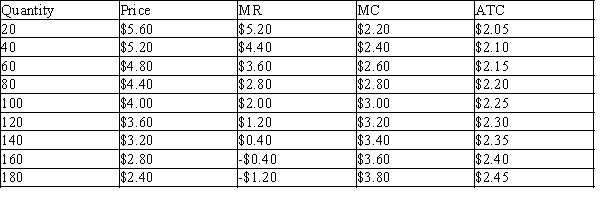Multiple Choice
Scenario 16-3
Peter operates an ice cream shop in the center of Fairfield. He sells several unusual flavors of organic, homemade ice cream so he has a monopoly over his own ice cream, though he competes with many other firms selling ice cream in Fairfield for the same customers. Peter's demand and cost values for sales per day are given in the table below. (Everyone who purchases Peter's ice cream buys a double scoop cone because it's so delicious.) 
-Refer to Scenario 16-3. Which of the following statements best describes the long run adjustment in this market?
A) One or more ice cream shops in Fairfield closes, increasing the demand for Peter's ice cream. Peter's profits increase and he sustains positive profits in the long run.
B) One or more ice cream shops in Fairfield closes, increasing the demand for Peter's ice cream. Peter's profits increase until he earns zero profit.
C) One or more new ice cream shops in Fairfield opens and competes with Peter for customers, reducing the demand for Peter's ice cream. Peter's profits decline until he incurs losses and exits the industry.
D) One or more new ice cream shops in Fairfield opens and competes with Peter for customers, reducing the demand for Peter's ice cream. Peter's profits decline until he earns zero profit.
Correct Answer:

Verified
Correct Answer:
Verified
Q13: In many college towns, private independent bookstores
Q18: In the long run, monopolistically competitive firms
Q24: A market structure with only a few
Q76: Brand names are rarely used to convey
Q571: Which of the following goods is most
Q576: Which of the following conditions is characteristic
Q578: A profit-maximizing firm operating in a monopolistically
Q580: Scenario 16-1<br>Suppose the following are the sales
Q582: When a firm exits a monopolistically competitive
Q583: A monopolistically competitive firm is currently charging